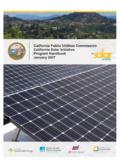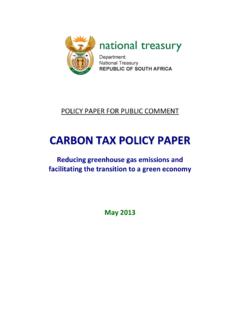Transcription of FINAL August 2016 - CCDC Boise
1 FINAL . August 2016. Table of Contents 1. 1 15. Accessible Parking 29. 2. Project 2 16. Safety and 31. 3. Sustainable Design & 7 17. 32. 4. Site 9 18. Signage and 35. 5. Site 10 19. 40. 6. Concept 11 20. Open or Enclosed Parking 7. Circulation and 13 21. Structural 42. 8. One-Way vs. Two-Way 15 22. Durability 46. 9. Other Circulation 20 23. Incorporating Other Land 47. 10. Access 22 24. Other 49. 11. Parking 23 25. Sustainable Operations & Management 50. 12. Parking Layout 25 26. Sustainable Ops & Mgmt. 51. 13. Parking Layout 27. 14. Pedestrian 28. Acknowledgement: This document was originally created by Carl Walker, Inc. in 2008. CCDC requested that Kimley-Horn update this document to incorporate changes in industry standards and practices especially in the areas of sustainable design best practices. Page |i 1. Introduction This document was developed for the Capital City Development Corporation as a guide for future parking structure design in Downtown Boise . It contains information to help developers and designers incorporate parking structure components into proposed projects.
2 The concepts presented will help produce functional, well- designed and patron friendly parking structures that will become valued infrastructure elements for the Downtown. The concepts are presented so that common design mistakes can be avoided by being addressed early in the design process. The document should be periodically updated to reflect state-of-the-art parking design practices and principles. To support this point, this document is an update to the original design guidelines document with the specific goal of incorporating recent advances in the area of sustainable operations and management strategies . This addition nicely complements the recent Parking Strategic Plan recommendations that puts a greater emphasis on mobility management strategies. It includes the following categories: Introduction Accessible Parking Requirements Project Delivery Safety and Security Sustainable Design & Accreditation Lighting Site Requirements Signage and Wayfinding Site Constraints Drainage Concept Design Open or Enclosed Parking Structures Circulation and Ramping Structural Systems One-way vs.
3 Two-way Traffic Durability Design Other Circulation Systems Other Considerations Access Design Incorporating Other Land Uses Parking Layout and Geometrics Sustainable Operations & Mgmt. Parking Layout Efficiency Sustainable Ops & Mgmt. Checklist Pedestrian Requirements In any future parking development project, it is highly recommended that a qualified parking structure design specialty firm be engaged in the project due to the unique characteristics and special design expertise required to develop a successful project. Page |1. 2. Project Delivery There are four primary project delivery methods commonly used to design and construct parking structures. Two design professional's handbooks titled the Design- Build Project Delivery and the Design/Contract-Build Project Delivery, published by the American Council of Engineering Companies (ACEC), are helpful references. Each method is described on the following pages, along with a graphical depiction of the contractual relationships for each: 1.
4 Design-Bid-Build (D-B-B) projects are those where the owner selects and contracts with the lead designer (Parking Consultant or Architect/Engineer). They in turn represent the owner in defining the project and preparing drawings and specifications to meet the owner's needs for competitive bidding to contractors. Often on public projects, the owner is required to select the lowest responsive and responsible . bid, with the contractors' qualifications often not given consideration. The D-B-B method is sometimes referred to as the traditional process and is still the most common method. 2. Construction Manager - Design-Bid-Build (CM D-B-B) is where the owner selects and contracts with the architect/engineer (A/E) who represents the owner in defining the project and preparing drawings and specifications to meet the owner's needs for bidding. However, the owner also retains a construction manager (CM) who works with the A/E. during the design phases, sets the project schedule, and performs construction cost estimates.
5 The CM bids the work to subcontractors for the various trades. This is a better method than D-B-B for projects where the owner wants fast track or phased construction. Page |2. 3. Design-Build (D-B) are cases where the owner retains a D-B contractor who in turn retains the A/E so there is a single entity responsible for both design and construction. Often the owner prepares or retains another A/E to prepare design build criteria documents as described below. The *. owner can select the D-B team based on qualifications and cost, consistent with the bidding documents. There has been more interest in D-B type projects recently because of owners who perceive benefits regarding cost, schedule, and risk management. 4. Design-Contract-Build (D-C-B) are projects where the owner selects and contracts with the A/E. The A/E prepares preliminary documents that are the basis for the owner contracting with the contractor early in the design process, rather than waiting for FINAL design documents to be prepared as for D-B-B.
6 This method combines the advantages of the D-B- *: Optional but recommended; A/E. B and D-B methods while reducing many disadvantages to allow the prepares design build criteria documents that are basis for contract with owner to have the most qualified A/E and contractor involved in their contractor. project from the design phase through the completion of construction. Page |3. In recent years there has been an increasing interest and use of Design-Build in the construction of parking structures. Legislation has been enacted in many states to allow D-B to be used by public entities because prior laws required publicly funded construction contracts to be awarded based upon completed design documents. Advantages of Design Build: Disadvantages of Design Build: Owner has a single point of responsibility for design The D-B contractor has the incentive to complete and construction. projects faster and less expensively which can mean Potential for better design and construction reduced quality of materials and workmanship.
7 Coordination because the A/E is working for the The owner has less involvement and control of the contractor. design because the A/E represents the D-B. Owner does not have to arbitrate disputes between contractor's best interests, not the owner's. Not only the A/E and contractor. is this a disadvantage for the owner, but it creates a Owner reduces their risk because the D/B contractor difficult conflict of interest for the A/E. is responsible for errors or omissions in the design The owner does not benefit from independent documents. advice and input from the A/E and contractor. Could be less administrative burden on the owner. Greater definition of the project is required up front Potential for accelerated schedule because the to define goals, objectives, and minimum contractor is onboard at the beginning and because requirements for project function, appearance, of the overlapping of design and construction work. quality, materials, operation, etc. prior to bidding to Potential for lower costs due to the contractor being D-B teams.
8 In greater control of the project and due to the More risk for D-B teams, which can negate the accelerated schedule. potential cost saving opportunities. Costs are well defined earlier in the process Page |4. When owners decide that D-B is right for their project, they can have a better chance of achieving a successful project utilizing the following procedures. Recommendations Regarding the Design-Build Delivery Method: 1. The owner should retain an A/E at project initiation to prepare the D-B. criteria documents. This allows the owner to have more input into the concept design and set standards and criteria for the project. Also, due to the uniqueness of parking structures, it is important to have the A/E led by a parking consultant or for a parking consultant to have a significant role on the design team. Parking structure built for 2. D-B criteria documents should clearly define the project scope, function, Baylor University using the appearance, quality, materials, and operations.
9 The level of Design-Build delivery method completeness of these documents varies, but generally they are in the 10. to 30 percent range (between Schematic Design and Design Development level of completeness). 3. The owner should use a very transparent selection process to hire the D-B. contractor, using the D-B criteria documents as the basis of the Request for Qualifications/Proposals (RFQ/RFP). 4. The selection process should consider the D-B teams' technical qualifications and experience in addition to cost. Typically, there is a weighting of selection criteria such as the experience and expertise of the firms and key personnel making up the team, experience of the team working together, technical merits of design, project appearance, quality and safety programs of the contractor, references, schedule, and cost. The selection criteria and weighting should be defined in the RFQ/RFP. 5. The owner's A/E who prepared the D-B criteria documents should continue on during the FINAL design and construction to represent the Page |5.
10 Owner's interest and help assure that the design and construction are completed in conformance with the D-B criteria documents. As an alternative to using the D-B method, the D-C-B or CM methods can often result in a project that meets the owner's best interests because: o The A/E contracts to the owner, thus representing their interests, not the contractor's, which should enhance quality o Design decisions can more easily be made that are in the best long-term interest of the owner, considering factors that will provide the lowest life cycle maintenance or operational cost, rather than emphasizing those that just provide the lowest first cost or schedule advantage o The CM or contractor is onboard early in the design process so the A/E. and contractor collaborate during design, enhancing innovation and opportunities to consider the contractor's cost saving ideas o Similar schedule and cost advantages compared to D-B. o Less risk for all parties as responsibilities can be allocated where they are appropriate Successful parking structure projects have been completed using all four of the construction methods discussed above.






